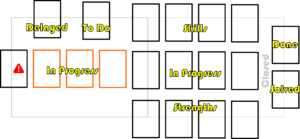Welcome to the facilitator guide of Agile SWOT.
So you have the game and now you want understand how to use it to coach your teams and leaders.
Here you can download a copy of the rulebook.
Why we needed Agile SWOT
This game has been designed having in mind the process of starting an adoption of a new way of working (WoW) by someone that has not a clear idea on possible impacts of this potential new way.
In particular I had in mind someone with a good waterfall experience that want to understand about agile.
This potential person would like to understand Agile using one of the tool he already used and SWOT analysis (link) is exactly what he needed.

SWOT analysis of the Agile adoption
The first exercise you may do is to ask your team (and yourself) what are the variables of an Agile adoption and how these could be mapped into a SWOT matrix. This is a very interesting exercise that actually has been also the starting point for creating the cards.
There are positive and negative points and all of them could be mapped properly in the matrix.
We didn’t want to explore all possible cases (every team can find a different SWOT matrix) so we have focused on some of the most common ones.
In the game there are twelve cards for each of four dimensions. Twelve is a good number to use different combinations so:
- Strengths: 3×4 cards; we have used the analysis of the Coaching Institute on the coach skills
- Weaknesses: 4×3 cards; we have listed the most common organisational blockers for adopting a change
- Opportunities: 6×2 cards; we have used the “enablers” used also in “The Agile Mind”, the game on the agile mindset
- Treaths: 3×3 + 2 + 1 cards; we have collected the most common situations a team is facing when adopting agile
All four decks are also composed in a different way to create different cases and show how various can be the situation.
Also each of the deck has a different mechanic, to show how the impact can vary. Some of them have effects, immediate or delayed, increase or decrease capacity, some cards have double usage, immediate or definitive, …
Note: A possible evolution of the game could be create 4 decks where all cards are really different. What do you think?
Understanding the flow of work
In a waterfall approach we know that the work is start-and-stop because you have the different stages where all work is collected. However in agile is essential understanding and optimising the flow of work. That’s why the basic mechanic of the game is to move the cards from an initial Backlog (To Do) to a final stage (Closed). And that’s why the game is happening mainly in “In Progress” area.

When you have a flow of work some basic rules could be showed and these are influencing the game: this is what happened when tracking the WIP (Work In Progress). In AGile SWOT you have a limited WIP and also you can see how blockers are influencing the dynamic of your game, so you need to figure out how to deal with these blockers minimising the impact on the flow and eventually its disruption.
The role of the team
What is not visible in Agile SWOT is the backlog of feature to be delivered, because this is not the goal of the game.
If you want to explore delivery dynamics you can play Agile SyS or maybe DS builders, both available by Agile Game Factory.
Here the backlog is related only to the transformation of the team, because this is what we want to explore and understand.
The level of maturity of the team is however relevant, because this is related to how the team will embrace the change. That’s why in the Team Behaviors deck you can find some example of good change. This deck has been designed as optional, however the testers realised that the game can expose how the team can make the difference in the transformation, Sessions of the game can be played mixing combinations ot Team Behaviour cards: you can play a first game with all behaviour, and maybe another one without (or maybe a limited number of) behaviours and explore how the transformation could be harder if the team is not supporting it.
Provide your feedback
In the material of the game you can find all references to provide your feedback on the game. You can also suggest improvements and maybe maybe describe how you are arranging the session and the final outcome.
If you publishing some articles share the link so I can add to the library, and maybe it may help other facilitators.
As agilist I am always welcomed constructive feedback.
Enjoy the game!